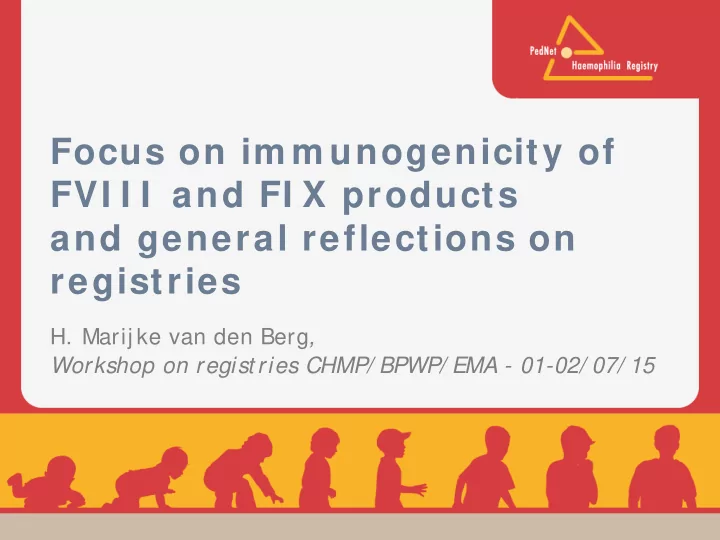

Focus on im m unogenicity of FVI I I and FI X products and general reflections on registries H. Marij ke van den Berg , Workshop on regist ries CHMP/ BPWP/ EMA - 01-02/ 07/ 15
2 Let’s start w ith the patient Monozygotic twins Factor VIII gene defect – Inversion Both treated with Advat e Patient A developed high-titre inhibitor after ICH and intensive treatment – >250 BU/ ml during 24 months Patient B had low-titre inhibitor – 3.5 BU/ ml during 4 weeks
3 Patient A: high-titre inhibitor after treatm ent for I CH 35000 250 IgG1 30000 Anti-FVIII IgG (ng/ml) Inhibitor titre (BU/ml) 200 IgG4 25000 Inhibitor titre 150 20000 15000 100 10000 50 5000 0 0 1 101 201 301 401 501 Days after first positive inhibitor titre
4 Patient B: low -titre inhibitor disappearing on ‘prophylaxis’ 300 4 Anti-FVIII IgG (ng/ml) 3.5 IgG1 Inhibitor titre (BU/ml) 250 IgG4 3 200 2.5 Inhibitor titre 150 2 1.5 100 1 50 0.5 0 0 1 8 15 22 29 36 43 50 Days after first positive inhibitor titre
5 Patients A and B: sum m ary Monozygotic twins, same gene defect, same product, same environmental factors Differing in – Age at start treatment – Intensivity of treatment (dose, time period) – Low-titre versus high-titre inhibitor – No ITI versus high-dose ITI
6 I nhibitor developm ent Fixed factors – Genetic, HLA, ethnicity, immune regulatory genes Time-dependent – Intensive treatment, dose, products, surgery, bleeding Astermark J. Blood 2015; 125: 2045
7 How to define inhibitors Maj or side effect is development of inhibitors Inhibitors are allo-antibodies that block the binding sites for factor VIII and IX Inhibitors occur very early after the start of treatment
Test method Confirmation of test FVIII mutation Frequency of Family history testing Ethnicity Immune regulatory genes Dose Peak treatment Intensive Inhibitors treatment Products
I nhibitor developm ent versus FVI I I genotype 25% Oldenburg J, et al. Haemophilia 2002; 8(Suppl 2): 23
10 I nhibitor developm ent versus FVI I I genotype 5883 patients with severe haemophilia A Gouw SC, et al. Blood 2012; 119: 2922
11 I nhibitor risk in m ild hem ophilia: I nsight study 20% Eckhardt C L, et al. Blood 2013; 122: 1954
12 Genetic factors: conclusion Genetic factors – Can not be changed in a given patient Patients with severe haemophilia – 60% have high-risk mutations – While 25% develop an inhibitor – Impact of immune regulatory genes* Non-genetic factors – Are important – Can be influenced * Astermark J. Blood 2015; 125: 2045
13 I m pact of fam ily history on age of diagnosis Griffiths AJF, et al. Introduction to genetic analysis. 10th ed., 2012
14 I m pact of fam ily history on age of diagnosis Large family Small family
15 I m pact of fam ily history on age of diagnosis According to the literature, 70% of patients would have a positive family history at diagnosis But prospective data show that presently over 55% have a negative family history* * Chambost H, et al. J Pediatr 2002; 141: 548 - Gouw SC, et al. Blood 2013; 121: 4046
Haem ophilia patient w ithout fam ily history Negative family history for haemophilia No suspicion of haemophilia at delivery Intracerebral haemorrhage as a neonate Diagnosis outside of haemophilia treatment centre No prospective collection of clinical data Mostly excluded from trials
17 Results from the PedNet registry Data May 2013 Cohort born 2000-2009 In total 622 children with severe haemophilia A At the first exposure day, 25% had to be treated for at least 3 days 9 children had an intracerebral haemorrhage – 8 of them (42% ) developed an inhibitor
18 Patient according to the Handbook Positive family history Gene defect available Diagnosis known at delivery Diagnosed and treated in a haemophilia centre Choice of product Clinical data prospectively collected Mostly included in trials
19 Studies of severe haem ophilia: Factors to consider w hen At diagnosis, over 55% of all newly diagnosed children with severe haemophilia have a negative family history – Will be diagnosed through bleeding – Mostly outside of haemophilia centre Not included in studies S election bias
20 Data from PedNet registry 73 children Age at diagnosis 0-55 months (IQR 0.3-11 months)
Early diagnosis Positive fam iliy history
Late diagnosis ( > 2 year) Negative fam ily history
23 Changing practice in inhibitor diagnosis Before 1990, inhibitors were suspected when the patient did not respond to treatment After outbreak inhibitor on plasma products, awareness increased S creening for inhibitors with frequency of testing up to every 5 exposure days
24 Changing practice in inhibitor diagnosis Modificat ion of Bethesda assay Cut-off value for positivity was decreased by the Nij megen modificat ion Further standardizat ion did not improve the large interlaboratory variation Advice: confirm a positive sample Faveloro et al. Semin Thromb Hemost 2014
25 Definition of inhibitor ( I STH-SSC) Clinically relevant inhibitor development – 2 or more positive titers – In combination with decreased FVIII recovery High-titer inhibitor development – Clinically relevant inhibitor with peak titer ≥5 BU/ml Blanchette VS, et al. J Thromb Haemost 2014; 12: 1935
26 Conclusions I Inhibitor development is influenced by many genetic and non-gentic factors High dosing increases the risk up to 3 times For the study of the impact of combined risk factors, data of large, similarly defined patients populations are essential 55% of patients with severe Haemophilia A are diagnosed after bleeding
27 Conclusions I I Differences in assays and in testing frequency have an impact on the numbers of patients diagnosed with inhibitors (low titre inhibitors) Variances in outcome can be limited by the definition of clinically important inhibitors Comparison of only high-titre inhibitor incidence will make studies more comparable
Recommend
More recommend